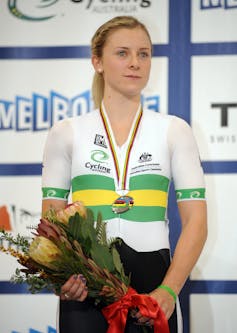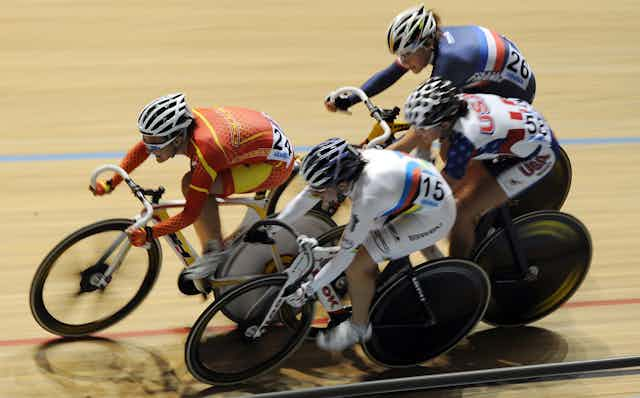With track cycling events now underway at the London Olympics, athletes from around the world are pushing themselves to the limit to outperform their rivals and, hopefully, claim gold.
Back here in Melbourne, my colleagues and I have been using artificial intelligence (AI) techniques to help give Australian track cyclists a competitive edge in the Games.
How? Well, we’re using machine learning – a sub-branch of AI that gets machines to learn from experience – to provide advice about team selection, training and performance strategies in the omnium - a new, and controversial addition to the Olympic track cycling calendar.
The omnium is a multi-leg track event introduced by the International Cycling Union (UCI) in 2007. It replaces events that are no longer on the Olympic calendar (the individual pursuit, time trial, points race and scratch race) with the aim of presenting equal opportunities for male and female cyclists.

The omnium has undergone a number of changes since its inception (such as the lengthening of events and addition of the elimination race in 2010) but the current version involves six events:
Flying lap (FL): a simple race against the clock over 250m.
Time trial (TT): a simple race against the clock, from a standing start. This is raced over 1km for men and over 500m for women.
Points race (PR): a race in which riders score points for sprint “primes” every 10 laps during the race and if they manage to lap the field. This race is held over 30km for men and over 20km for women.
Elimination race (ER): a bunch race with an intermediate sprint every two laps. The last rider at each sprint point is eliminated with the last remaining rider being dubbed the winner.
Individual pursuit (IP): a race in which two riders start at opposite sides of the track and race to complete the distance in the shortest possible time. The IP is raced over 4,000m for men and over 3,000m for women.
Scratch race (SR): Raced over 16km for men and 10km for women, this is a straightforward event, with the first person to cross the finish line being dubbed the winner.
In each of the six omnium events, the first-placed rider gets one point, the second-placed rider two points, and so on. The rider with the fewest points after all six events is the winner of the competition.
So what’s the link between cycling and AI? Well, first of all, it’s helpful to remind ourselves that machine learning is the subsection of learning in which AI systems attempt to learn automatically.
A machine-learning system can take advantage of data (such as a cyclist’s placing in the individual pursuit) to capture characteristics of interest of their unknown underlying probability distribution (such as the likelihood of winning gold, or any medal, given a specific performance in the individual pursuit).
In this way, machine learning provides important knowledge for strategic decision-making to support elite athletes:
- in deciding which cyclists should be chosen to train for omnium competitions
- in advising coaches and cyclists on what performances are required in each of the six constituent events in order for the cyclist to obtain a medal, and
- in the provision of real-time advice during the event as to what performance the cyclist must attain in the remaining events to obtain a medal.
Through the use of a machine learning technique known as Bayesian networks (a type of statistical model, see above), we found that, contrary to the intuition of most cycling experts, the new six-event omnium disadvantages endurance riders compared to sprinters.
We also found that the rankings of riders in the time trial and flying lap individual events are most correlated with the overall final standings of riders.

Accordingly, omnium riders may and should put more emphasis on the non-interactive (individual) series events (the flying lap, time trial, and individual pursuit) to maximise their overall success.
The addition of the elimination race to the omnium (in 2010) was shown to have no correlation with overall success nor with any other individual event in the omnium so far. Nevertheless, a poor performance in elimination race (finishing in the bottom half of the field) makes the probability of obtaining a medal very low.
This has led us to conduct further investigations. Our findings suggest the elimination race can be classified into three distinct components – laps 1-18, 19-30 and 31-50 – and that in the first third of the race, cyclists should avoid being placed low on the track and at the bottom of the peleton.
But in terms of the big picture, as long as riders can achieve an overall score up to a certain point (41 for men and 42 for women), it almost doesn’t matter how bad the ranking they achieve in any one single individual event – they may still win a medal.
Analysis of timed components of the six-event omnium also shed light on the required finish time in these components that’s necessary for winning a medal. For instance, for a male athlete to win a medal, he needs to ride a time of 4 minutes 30 seconds (or less) in the individual pursuit.
These findings are assisting selectors, coaches, and cyclists by allowing more informed and enhanced decision-making. Our research has been conducted in association with Cycling Australia who suggested the topic, read our results, and make recommendations about restructuring the questions we ask. The information was used and evaluated at the Track Cycling World Championships, held in Melbourne in April 2012.
So while you’re sitting on the couch in the small hours of the morning, watching Australia’s track cyclists battle it out in the omnium over the next four days, it’s worth considering the preparation that’s gone into the efforts you see on the screen, both physical and statistical.
Further reading:
-
Track Cycling World Championships: the making of modern sprinters - David Rouffet, The Conversation

